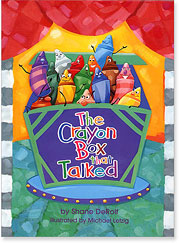 The Crayon Box that Talked is written by Shane DeRolf and illustrated by Michael Letzig. It is geared toward preschool or kindergarten students and I would rate it 4 out of 5 stars.
The Crayon Box that Talked is written by Shane DeRolf and illustrated by Michael Letzig. It is geared toward preschool or kindergarten students and I would rate it 4 out of 5 stars.This book is about a young girl who goes to a toy store to find a box of crayons that are all up in arms with each other. They don’t like one another, with no reasons given for the animosity. The girl purchases the crayons and when she gets home, she begins to draw a picture with all the colors, showing that they are all needed to complete a beautiful picture. The crayons also learn that they have to work together in order for art to be created and they can blend together to create new colors of beautiful things. In the end, the crayons are getting along and embrace each other since everyone is needed.
Using this book in an elementary classroom, especially the younger grades, will be a simple way to teach diversity without connecting the idea to people yet. Since it is the crayons (which all happen to be different colors, like people) that are fighting, it is somewhat unlikely that students will immediately think that the book is metaphorical. Students will learn that everyone needs to work together to get everything needed done. Also, it is a great way to introduce the idea of mixing colors together to get a new one. Since the crayons blend and color over one another to form new shades, students can try this on their own to experience the act.
Since the book is also written in rhyme, it will especially appeal to the younger children by keeping their attention in tune with the rhythm of the story. A lesson involving this book could consist of students getting a pile of crayons and having to use every color coherently to create a picture. If students can see how well the colors work together and benefit the picture, they might make the connection on their own about how each person is important to a community. This book could be used to introduce diversity or the components of a group of people.
There is a whole mini-unit that can be used based on this book.
No comments:
Post a Comment